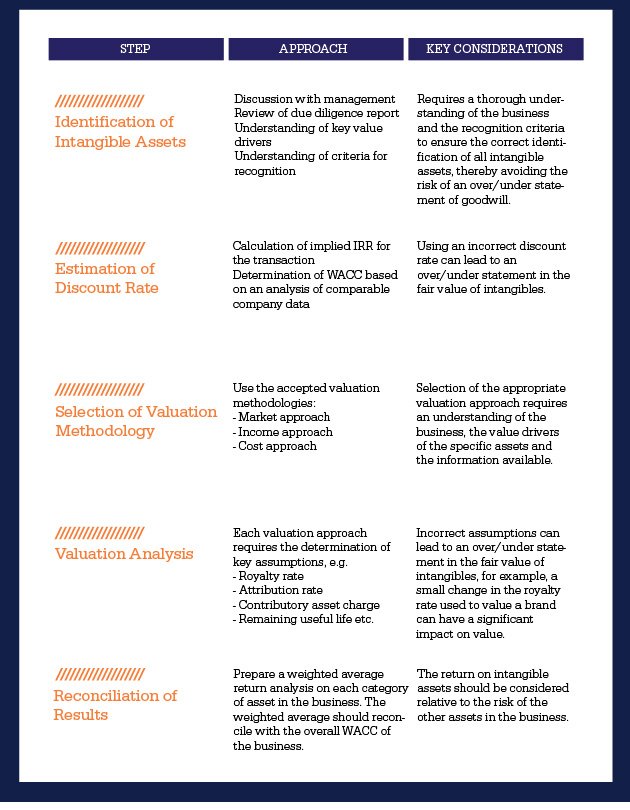Intangible Assets - Recognizing Their Value
Intangible assets frequently underpin the price a buyer is prepared to pay for an acquisition. Brands, customer relationships, patents and exclusive supply agreements are all forms of intangible assets that give acquirers comfort and visibility over future earnings of acquired entities, and are key value drivers in a business.
International financial reporting standards (IFRS) and generally accepted accounting principles (GAAP) recognize this issue and require all assets and liabilities, tangible and intangible, acquired as part of a business combination to be valued to arrive at the residual amount to be attributed to goodwill. This requirement has put intangible assets firmly in the spotlight as companies must go through a process of identifying and valuing these assets in order to recognize them separately to goodwill. In addition, as shareholders have become more familiar with intangible assets, their recognition has become increasingly important to reflect the value drivers of an acquisition.
A key concern for companies recognizing intangible assets is their impact on the financial statements, in particular on earnings, as all definite lived intangible assets are amortized over their remaining useful life. This is important for companies where an acquisition can have a significant impact on earnings due to a large portion of the purchase price being allocated to goodwill and intangible assets.
In order to address these concerns companies should consider performing a high level estimate of the fair value of the intangible assets during the due diligence phase. This will inform management on the potential amortization charge and enable them to determine whether the overall impact on earnings is acceptable. The detailed work can then be carried out post acquisition.
Companies should ensure they go through a robust identification and valuation process to make certain that the fair value of the intangible assets are accurately reflected in the financial statements and that the remaining useful life assigned to each category of asset reflects its nature and importance to the business. Set out below is a high level overview of the key steps in the identification and valuation of intangible assets, together with the key considerations for companies at each step of the process.
Impairment
Goodwill and indefinite lived assets are subject to impairment testing at least annually. The risk of impairment of previously recognized intangible assets is another key concern for companies. To mitigate against the risk of future impairment, it is important that the assumptions used to value the intangible assets are robust and supportable.
However, it is also important to note that these valuations are carried out based on the assumptions and projections available to the valuer at the time the deal is completed. A subsequent decline in market conditions may no longer support those deals completed at peak market valuations and may indicate an impairment in the fair value of previously recognized intangible assets.
It is important that a business facing an impairment charge completes a thorough evaluation of its goodwill and intangible assets in order to arrive at a fair value for those assets which is supportable by the current business and does not result in further write downs in subsequent years.
How We Can Help
Chronos Capital’s team has depth of experience in assisting companies to deal with the complex issues of identifying intangible assets, determining their value and estimating their useful lives. We work closely with management to gain a thorough understanding of the acquired business, the rationale for the acquisition and the assumptions underpinning the value of the transaction.
In addition, where it is considered that a change in market conditions may have led to an impairment in the fair value of previously recognized intangible asset, we assist companies in valuing those assets and quantifying the level of impairment.
Identification of Intangible Assets
We tailor each engagement to recognize the unique value drivers inherent in each transaction, while also bringing pour experience and knowledge of the intangible assets recognized a wide range of industry sectors. We assist clients in the valuation of intangible assets including, but not limited to, the following:
Marketing-related intangibles
Trade names
Trademarks
Brands
Non-compete agreements
Customer-related intangibles
Customer lists
Customer contracts and related customer relationships
Non-contractual customer relationships
Order or production backlog
Technology-related intangibles
In-process research and development
Patents
Software
Databases
Trade secrets
Contract-related intangibles
Supply agreements
Licensing agreements
Service contracts
Franchise agreements
Favorable/unfavorable agreements
Valuation of Intangible Assets
We have extensive knowledge in performing the valuation of intangible assets using the approaches and methodologies accepted under IFRS and GAAP. The two most conventional valuation approaches used are summarized as follows:
Market Approach: This approach assumes that the fair value of an asset reflects the price at which comparable assets have been purchased in transactions under silmilar circumstances.
Income approach: This approach is based on the premise that the value of a security or asset is the present value of its future earning capacity.


